You are hereBlogs / WcP.Scientific.Mind's blog / Nature runs away from human pollution into deep sea to sustain its mysterious miracles - unidentified marine life.
Nature runs away from human pollution into deep sea to sustain its mysterious miracles - unidentified marine life.
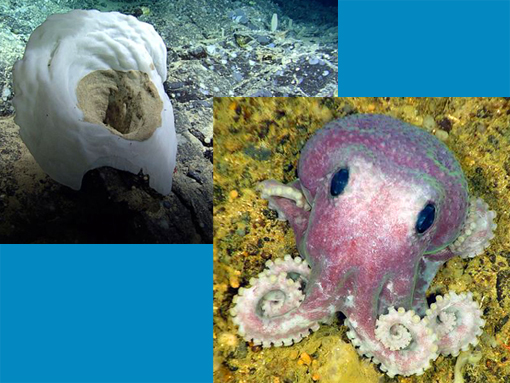
Spectacular deep-sea species: newly discovered purple octopus and species of vase sponge was one of the bottom dwellers.
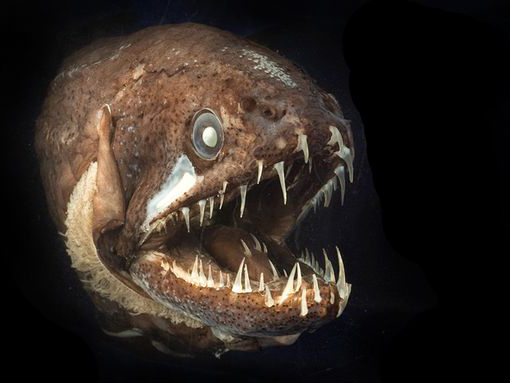
Australia's dragonfish uses many fangs to hook hard-to-find prey in the cold, dark depths.
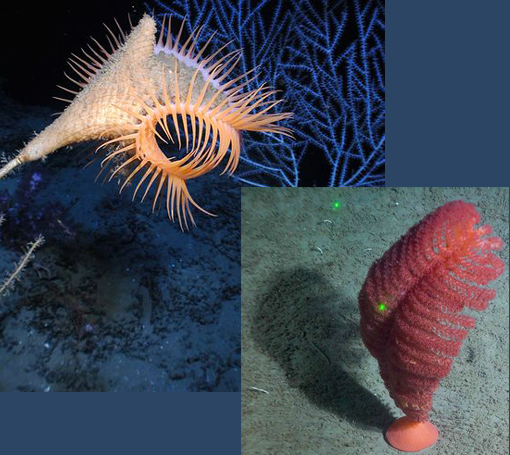
Top left: Gulf of Mexico's Venus flytrap anemone acts much like its terrestrial namesake, stinging its prey with an array of tentacles. Bottom right: an unidentified sea pen discovered on Atlantic coast off Newfoundland.
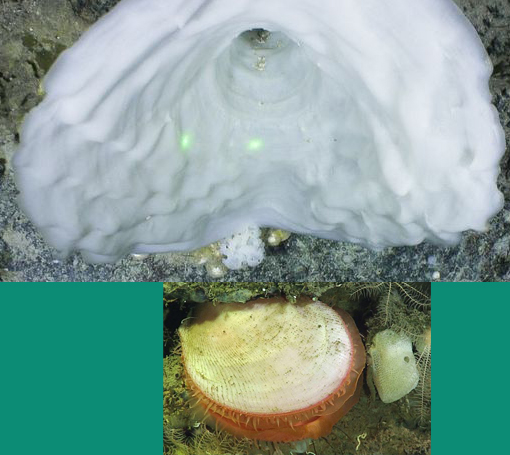
Top: unrecognizable sponge species found on volcanic mounds off Newfoundland. Bottom: recently identified species of bivalve mollusk was also discovered in survey of Newfoundland depths.
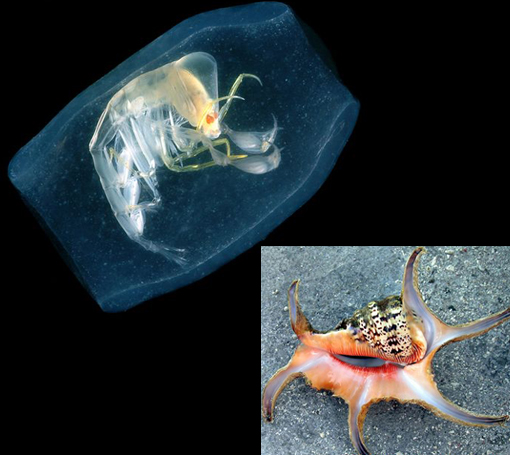
Phronima sedentaria sets up house by attacking and then hollowing out a transparent jellyfish-like animal called a salpa. Inset: Found in China, the spider conch a mollusk, one of the most common groups of species in the new Census of Marine Life inventory.
(quote)
"Spectacular" Deep-Sea Species - Newly Discovered Purple Octopus, and Species of Vase Sponge Was One of the Bottom Dwellers
New Purple Octopus? An unidentified purple octopus (pictured) is one of 11 potentially new species found this month during a deep-sea expedition off Canada's Atlantic coast, scientists say. Still at sea, a team of Canadian and Spanish researchers is using a remotely operated vehicle called ROPOS for dives off Newfoundland with a maximum depth of about 9,800 feet (3,000 meters). The 20-day expedition aims to uncover relationships between cold-water coral and other bottom-dwelling creatures in a pristine yet "alien" environment, according to the researchers' blog. "It's been really spectacular," Ellen Kenchington, research scientist with the Fisheries Department of Canada—one of the organizations involved in the project—told Canada's CTV News website. "It's really changing our perception of the diversity that's out there. ... We're seeing new species in deeper waters."
Vase Sponge - A possibly new species of vase sponge was one of the bottom dwellers discovered during the expedition. The simplest multicellular animals, sponges have no organs but possess many "pores," which lead to canals and chambers, according to Bellarmine University.
Hard-to-See Sea Creatures Revealed: Australia's "Terrifying" Dragonfish
Fang-Tongued Fish - Australia's "terrifying" dragonfish uses its many fangs -which even stud its tongue - to hook hard-to-find prey in the cold, dark depths, scientists say. The banana-size fish is one of tens of thousands of both known and new species included in a new inventory released today by the Census of Marine Life, a decade-long ocean-exploration project.
The first-of-its-kind "roll call" of marine species from 25 diverse ocean regions is a prelude to the census's final summary of up to 230,000 species to be released October 4, census scientists say. To create the inventory - published Monday in the journal PloS One - scientists combined years of census data with previous research on the richness of ocean species. Species counts in each of the 25 areas ranged from 2,600 to 33,000, with an average of about 10,750 per region. Altogether census scientists found more than a hundred thousand species in the 25 regions.
"This inventory was urgently needed for two reasons," report lead author Mark Costello, of the Leigh Marine Laboratory at New Zealand's University of Auckland, said in a statement. First, not knowing what species ply the oceans "impairs society's ability to discover and describe new species," Costello said. The research may also serve as a base line, helping scientists to track future extinctions: "Marine species have suffered major declines - in some cases 90 percent losses - due to human activities and may be heading for extinction - as happened to many species on land."
Deep Sea Unidentified Sea Pen and "Stunningly Beautiful but Deadly" Venus Flytrap of the Sea
Unidentified Sea Pen - An unidentified sea pen belonging to the order Pennatulacea has been discovered during the July 2010 expedition on the Atlantic coast off Newfoundland. Actually soft corals, sea pens are so named because their rows of polyps resemble old-fashioned quill pens, according to the University of California Museum of Paleontology.
Venus Flytrap of the Sea - "Stunningly beautiful but deadly," the Gulf of Mexico's Venus flytrap anemone acts much like its terrestrial namesake, stinging its prey with an array of tentacles, according to the U.S. Geological Survey.
The species' native Gulf - along with the Mediterranean, China, the Baltic, and the Caribbean - are most under threat from human activities, the Census of Marine Life report noted. For instance, nutrients in sewage and fertilizer washed from the land are degrading these marine habitats by creating oxygen-free "dead zones," the report says. What's more, the Gulf of Mexico oil spill may worsen these dead zones, as well as wield untold damage to the animals at the bottom of the food chain.
Ocean Life: Unidentified Sponge, and Newly Discovered Species of Bivalve
Unidentified Sponge - This unrecognizable sponge species is among the "major biological highlights" found on volcanic mounds off Newfoundland on July 20, according to the project blog. "What an unexpected dive!" project scientists wrote after seeing this sponge, black corals, and other oddities.
New Species of Bivalve - This recently identified species of bivalve mollusk was also discovered in the July survey of the Newfoundland depths. Bivalves - known for their "hinged," two-sided shells - can burrow into sediment or live on the ocean floor, according to the University of California Museum of Paleontology. Some species even snap their shells open and shut to swim.
More Found by Sea Surveys: Corpse Nursery, and Spider Conch
Corpse Nursery - Phronima sedentaria sets up house by attacking and then hollowing out a transparent jellyfish-like animal called a salpa. The tiny crustacean then lays its eggs inside the "barrel," according to the Woods Hole Oceanographic Institution. When the babies hatch inside, the female, now outside the barrel, "watches over" her babies by pulling the makeshift nursery around via hooked claws. Phronima's native Gulf of Mexico (see map) is among the five most diverse areas surveyed in the new inventory, along with China, the Mediterranean Sea, Australia, and Japan, according to the new Census of Marine Life report. For instance, Australia and Japan are each home to about 33,000 species. By contrast less diverse regions such as the Baltic or the northeastern U.S. each have about 4,000 known species.
Spider Conch - Found in China, the spider conch (pictured) is a mollusk, one of the most common groups of species in the new Census of Marine Life inventory. Mollusks such as squid, octopus, snails, and slugs make up 17 percent of the named species found. Only crustaceans, such as crabs and lobsters, were more plentiful, at 19 percent, the report says. Well-known marine vertebrates such as whales and sea lions make up less than 2 percent of the survey, scientists noted.
(unquote)
Photos courtesy of Bedford Institute of Oceanography, Julian Finn, Museum Victoria, Shaoqing Wang, I. MacDonald, H. Bahena, Felder, D. L. and Camp, D. K. (eds.) 2009 and Gulf of MexicoOrigins, Waters, and Biota. Vol. 1. Biodiversity. Texas A&M Press, College Station, Texas



















Fabulous images. Thank you so much for sharing them. Do you own the copyrights, or can you point me to the owner, please? Would love to share one or two with my readers, with full credit, of course. Thoroughly enjoyed taking a break and a vicarious walk on the sea floor.